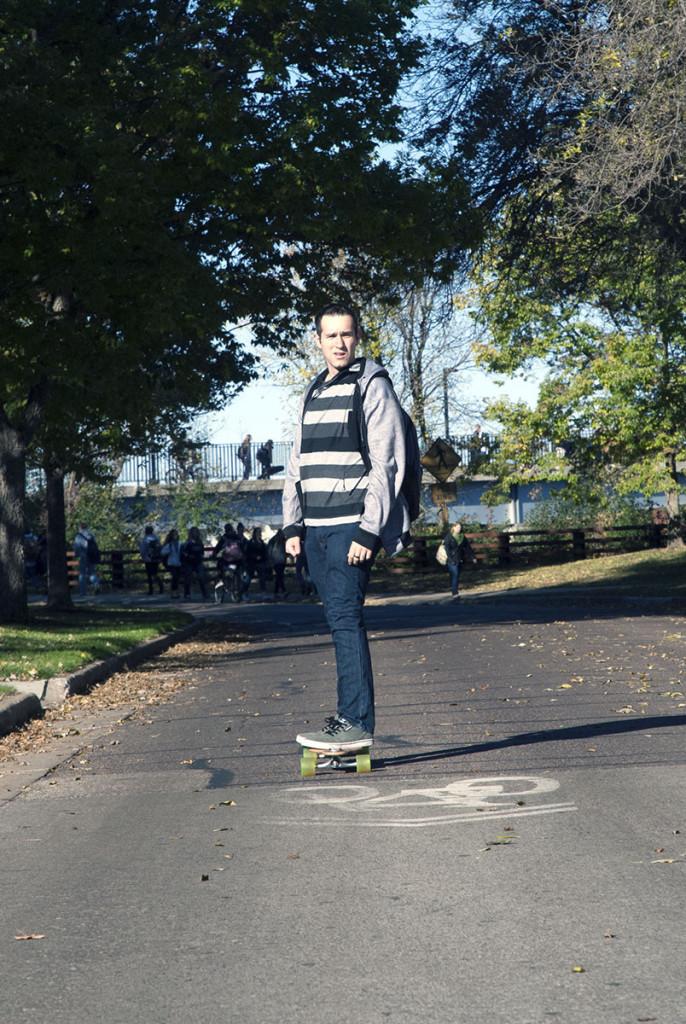Safe crossings
University Police outlines rules for non-motorized citizens to maintain order on sidewalks and roads
On a campus of more than 10,000 students, walkways and streets are bound to be crowded at some point during the day.
Students also have many ways of getting to and from their destination spots, whether it is by bus, bicycle, board or foot.
With all of that motion surfacing throughout UW-Eau Claire and its immediate surrounding area for five of the seven days of the week, University Police said precautionary steps must be taken to keep everyone safe.
Longboarding and skateboarding
A UW System ordinance barrs longboarding and skateboarding from all campuses in the public school system in Wisconsin.
However, Sergeant Joel Field of the University Police Department said he and his staff are fairly lenient on this rule because they realize it isn’t very practical.
“As long as it’s used as a mode of transportation, we usually don’t enforce that until unsafe behavior is seen,” he said.
He said unsafe behavior can be riding in the middle of the street or riding down the hill.
If a sidewalk is crowded, especially during a passing time, Field recommends getting off the board and walking it the rest of the way instead of riding in the street because that’s where accidents can happen.
He also said another issue is just a lack of awareness on the ordinances present to longboarders to skateboarders.
If he sees somebody engaging in risky behavior on a board, he generally will issue a warning if he has never seen the person before and treat it more as a learning experience instead of a disciplinary conversation.
He said a lot of students don’t understand why they get pulled over, which is why he likes to have an initial conversation instead of whipping out a ticket.
“We try to be really open and educational on it; we don’t want to stop and just write them a ticket,” he said. “A lot of them don’t know what they can or can’t do. If it becomes a repeat thing or remember you, that’s when we usually write them a ticket.”
Senior Mike Macalalad uses a skateboard frequently, including as a method to get to class. He said he was unaware of the ordinances, and there could perhaps be a better way to communicate this with students, but he has never had an issue with law enforcement.
“I think if someone is just using it to push to and from class, it isn’t really much of a problem,” he said.
Unlike bicycles, Field said there have only been about one or two incidents from people getting hurt on boards, and that usually stems from riding down the hill or doing tricks, both of which will cause a police officer to stop and at least talk to the student.
From a student’s perspective, Macalalad said he feels safe riding his board to campus, and it is a pretty accommodating place to ride. He thinks those who are experienced riders aren’t the ones who would be causing unsafe situations.
“Once you get on a board, you pretty much know how to use it forever,” he said. “Everybody who does use it as a method of transportation is generally pretty safe.”
The fine for improper use of a board is $200.50.
Pedestrian safety
While it seems more prevalent to have a dangerous situation occur with either a bike or board, it can still make its way to somebody on foot, as well.
Field said there is a common misconception by pedestrians to think they have more rights than they actually do.
“If you’re a pedestrian and on a curb, you can’t walk out until it is safe to do so,” Field said. “You can’t just walk out in front of a car and expect it to stop on time.”
If an officer is around, that can actually be considered a violation, which is sudden pedestrian movement. That has a fine of $162.70 and $187.90 after the first offense.
In terms of general safety, Field said drivers are often distracted and may not see the walker or runner in the crosswalk. Once you’re at a certain point in the crosswalk and can safely walk through you it, then you have a right to continue without stopping.
He said the best rule of thumb is to make eye contact with the driver before you enter the street.
“When in doubt, wait it out,” he said.
He also said people should be cautious of distracted walking like being on the phone or listening music. He suggested listening to music with one earbud out and looking up for phone every couple of seconds.
Overall, he said most people do a good job of following the rules, but in order to make the safest environment possible, everyone needs to abide by the law and use good judgement.










